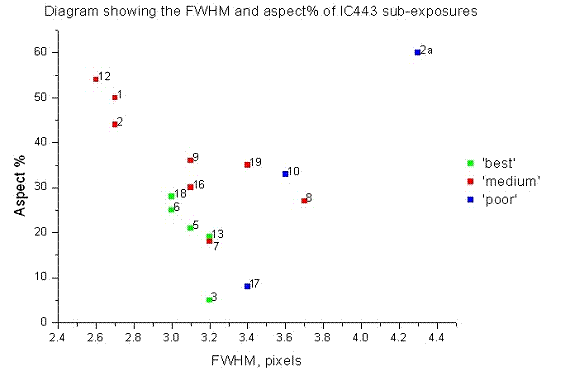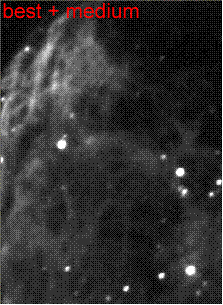Rejection
versus acceptance of poor quality deep sky sub-exposures
 Introduction:
Conventional wisdom states that deep sky sub-exposures with distorted stars due
to e.g. guiding problems, flexure, wind, etc. should be discarded and only
‘good’ images used for stacking. I find that such a rejection does very little
to improve the final image quality – in fact the limited S/N ratio when using
few sub-exposures is a much worse problem.
Introduction:
Conventional wisdom states that deep sky sub-exposures with distorted stars due
to e.g. guiding problems, flexure, wind, etc. should be discarded and only
‘good’ images used for stacking. I find that such a rejection does very little
to improve the final image quality – in fact the limited S/N ratio when using
few sub-exposures is a much worse problem.
Setup:
Borg 100ED f=640mm refractor, FLI DF2 focusser, SBIG CFW8 filter wheel, SBIG
ST10XE camera (2.2 arcsec/pixel), Takahashi EM-10 mount.
Image
aquisition: Target was IC443 through a H-alpha
filter. My guiding performance was quite poor, I suspect due the use of a very
faint guide star (mag. 8.5, 20sec guide exposure time, typical star adu=800). A
total of 18 images each with 900sec exposure time were aqcuired.
Image
processing and analysis: I performed the usual
basic callibration (darkfield subtraction, flat fielding). The images were then
manually inspected for ‘star image quality’ and sorted into four categories.
Central region closeups of the images are shown below along with measured
stellar FWHM and aspect ratio (percentage difference between star diameter
along elongation direction) using CCDInspector:
Best images: 3,5,6,13,18;




 (‘best’ – average FWHM
= 3.1, average aspect = 20%)
(‘best’ – average FWHM
= 3.1, average aspect = 20%)
Medium images: 1,2,7,8,9,12,16,19;







 (‘medium’
– average FWHM = 3.1, average aspect = 37%)
(‘medium’
– average FWHM = 3.1, average aspect = 37%)
Poor images: 2a,10 ,17;



(‘poor’
– average FWHM = 3.8, average aspect = 34%)
Very poor images: 14,15;


(‘very
poor’ – measurements of CCDInspector cannot be trusted due to severe distortion)
The precise categorization of a single
image is always subject to discussion, but the general trend from ‘good’ to
‘very poor’ should be fairly clear. Another way of visualizing the
categorization is done in the plot below:

Each dot corresponds to an image
(labelled). The closer an image is to (0,0) the rounder, smaller stars it has.
As you can see my initial categorization is pretty good. The only thing that
jumps at the eye is to switch category on image 7 and 18, but doing so will not
affect my general conclusion.
I will now try registering and stacking
(using Registar 1.0, median/average combine) these images in the following
manner: best, best + medium, best+medium+poor. Closeup of a central region is
shown below for each resulting image:



As expected the S/N ratio increases with
number of images used for the stack. However, it is – to me, at least – very
surprising that the star roundness / image sharpness is very nearly the same.
To quantify this I measured the stellar FWHM and aspect ratio of the image crop
above:
FWHM
(pixels) aspect %
best: 3.10 11
best+medium: 3.10 23
best+medium+poor: 3.02 19
No significant differences can be seen in FWHM and aspect ratio
compared to the single images in the ‘best’ category!
In fact, the aspect% of stacked images is lower
than the group averages. Using only the best images does produce slightly
rounder stars (11% aspect ratio vs. ~20%), but the reduced S/N ratio dominates
the image.
Conclusion:
For the images used here careful filtering of sub-exposures according to star
quality does not yield significant improvement in the stars of stacked image.
In fact, the S/N improvement when using most of the sub-exposures is a much
more prominent effect. For optimal processing one could use the three stacked
images selectively according to region brightness, i.e. ‘best’=brightest
regions (stars), ‘best+medium’=mid-level brightness regions (weak stars, main
nebulosity) and ‘best+medium+poor’ for the weakest regions such as background
and very faint nebulosity. That way most of my hard earned data will be used while
displaying only the best from each image stack. Does this conclusion depend on
what images are used and the kinds of distortions they suffer from? I don’t
know, but I have seen this effect before during my deep sky work. I am very
interested in hearing about YOUR experience of this!
Feb. 20, 2010 – Mikael
Svalgaard
www.leif.org/mikael , mikael.svalgaard@gmail.com